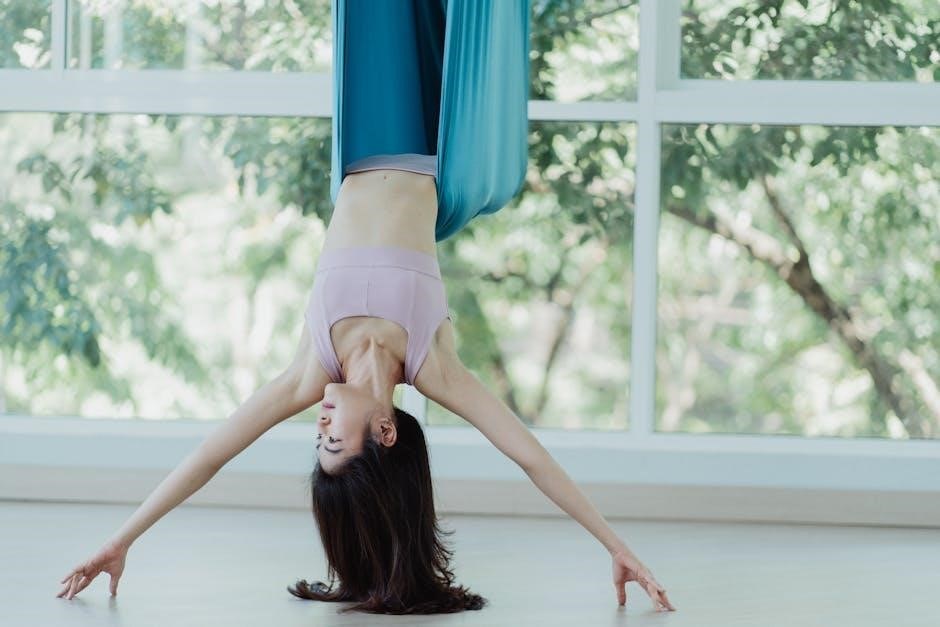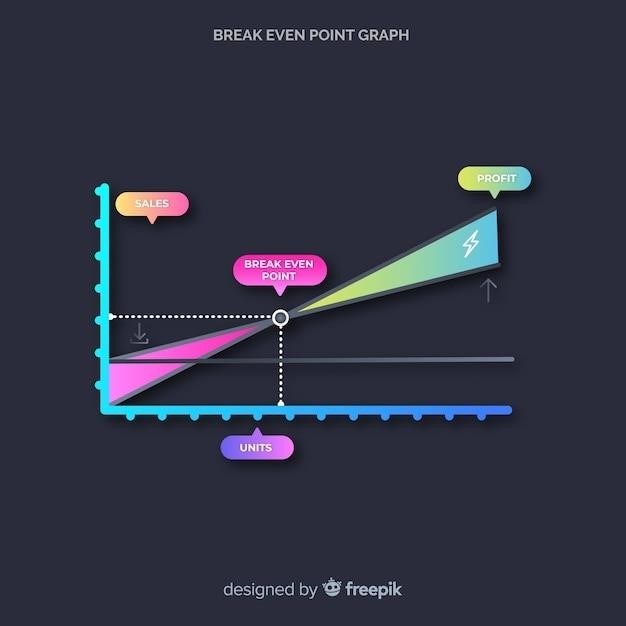Vinyasa Flow Yoga is a dynamic practice linking movement with breath, creating a flowing sequence. Rooted in Hatha Yoga, it combines dynamic Ashtanga-inspired flows, offering a versatile practice for all levels.
Definition and Origin of Vinyasa Flow Yoga
Vinyasa Flow Yoga, also known as “flow yoga,” is a dynamic practice that links movement with breath. Originating from Hatha Yoga, it draws inspiration from Ashtanga Yoga’s dynamic sequences. The term “Vinyasa” refers to the synchronization of breath with movement, creating a flowing transition between poses. Unlike traditional yoga forms with fixed sequences, Vinyasa Flow is more intuitive, allowing practitioners to adapt movements based on their comfort and flow. This style emphasizes fluidity and connection, fostering a meditative “flow state.” Evolving from ancient roots, Vinyasa Flow has become a popular modern practice, often referred to as “power yoga,” focusing on strength, flexibility, and mindfulness. Its adaptability makes it accessible to all levels, promoting holistic well-being.
Key Principles of Vinyasa Flow Yoga
The core principle of Vinyasa Flow Yoga is the synchronization of breath with movement, creating a seamless flow between poses. This practice emphasizes fluid transitions, often referred to as “linking breath to motion,” which cultivates a meditative flow state. Another key principle is the use of Sun Salutations as a foundation, serving as a warm-up and a way to connect with the rhythm of the breath. Adaptability is also central, as sequences can vary based on individual needs and goals. While structured, Vinyasa Flow allows for intuition and creativity, making it accessible to all levels. The practice aims to unite physical movement, breath, and consciousness, fostering holistic well-being and mindfulness.
Benefits of Practicing Vinyasa Flow Yoga
Practicing Vinyasa Flow Yoga offers numerous physical, mental, and emotional benefits. It enhances strength, flexibility, and cardiovascular health through dynamic sequences. The synchronized breathing improves lung capacity and reduces stress. Regular practice boosts balance and coordination while fostering mindfulness and concentration. Vinyasa Flow also promotes weight management, tones muscles, and improves circulation. Mentally, it reduces anxiety and depression by releasing endorphins and creating a sense of calm. The flowing movements help detoxify the body and enhance overall well-being. This practice is adaptable, making it suitable for all fitness levels, from beginners to advanced practitioners, ensuring a holistic approach to health and self-care.
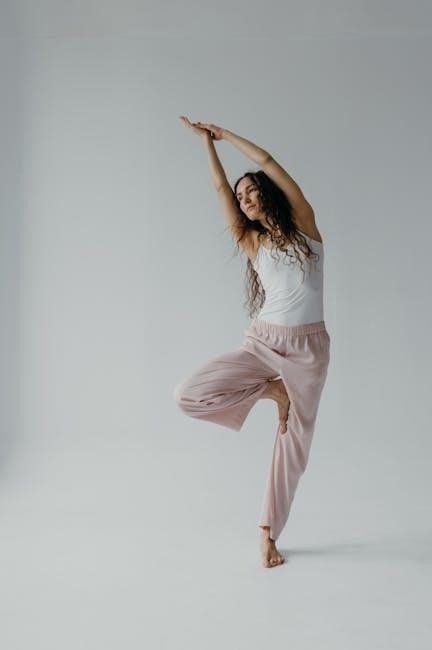
Understanding the Vinyasa Flow Yoga Sequence
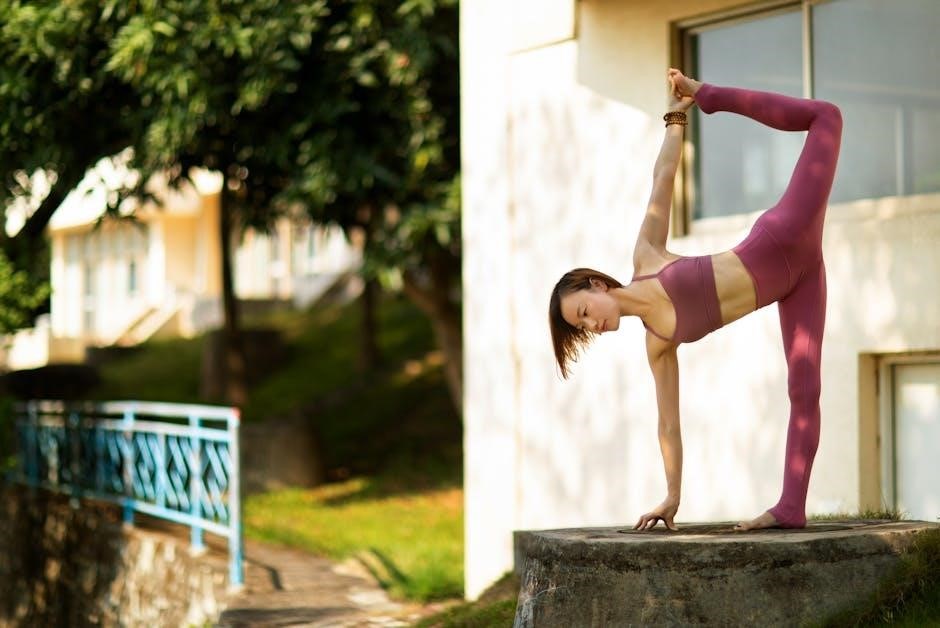
Vinyasa Flow Yoga involves synchronized movement with breath, creating a flowing sequence. It emphasizes smooth transitions between poses, connecting the body and mind through dynamic, breath-guided flows.
Core Components of a Vinyasa Flow Sequence
A Vinyasa Flow sequence typically begins with a warm-up, incorporating sun salutations to awaken the body and synchronize breath with movement. Core components include foundational poses like Mountain Pose, Plank, and Downward-Facing Dog, which build strength and alignment. Transitions, such as flowing from Plank to Chaturanga to Upward-Facing Dog, are central to the practice, linking movement with breath. Sequences often incorporate balancing poses, twists, and backbends to enhance flexibility and focus. Variations may include lunges, warrior poses, and inversions, depending on the practice’s intensity. The flow concludes with calming poses like seated forward bends and Savasana to promote relaxation and reflection, ensuring a balanced and holistic practice.
Importance of Breath-Synchronized Movement
Breath-synchronized movement is the cornerstone of Vinyasa Flow Yoga, as it unites the body and mind through conscious breathing. By coordinating each movement with an inhalation or exhalation, practitioners experience a meditative flow, enhancing focus and concentration. This synchronization also ensures smooth transitions between poses, reducing the risk of injury. Breathing deeply and rhythmically helps cultivate internal heat, which detoxifies the body and improves circulation. Moreover, linking breath with movement allows for a more intuitive practice, where the body moves in harmony with the breath, fostering self-awareness and a deeper connection to one’s inner rhythm. This harmonious union of breath and movement transforms the practice into a holistic experience, benefiting both physical and mental well-being.
Transitioning Smoothly Between Poses
Transitioning smoothly between poses is essential in Vinyasa Flow Yoga, as it maintains the flow’s continuity and grace. Each movement is guided by the breath, allowing practitioners to shift seamlessly from one pose to the next. This fluidity enhances the meditative quality of the practice, creating a harmonious connection between body and breath. To achieve smooth transitions, it’s important to move slowly and mindfully, ensuring alignment and stability. The repetitive sequences, such as the classic vinyasa (Plank to Chaturanga to Upward-Facing Dog to Downward-Facing Dog), are designed to build strength and familiarity, making transitions more intuitive over time. Smooth transitions not only improve the overall experience but also prevent injuries and promote a deeper understanding of the practice.
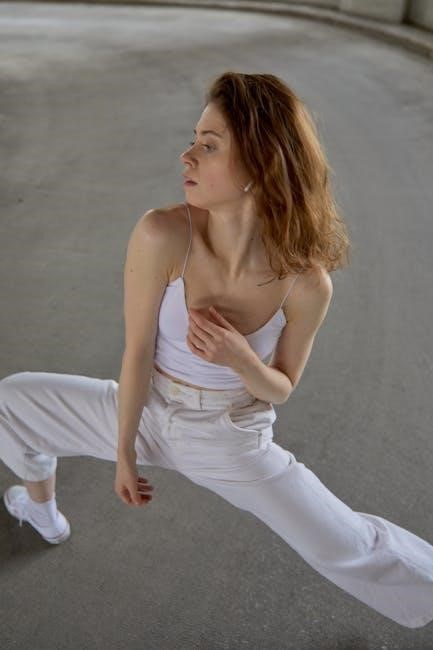
Popular Vinyasa Flow Yoga Sequences
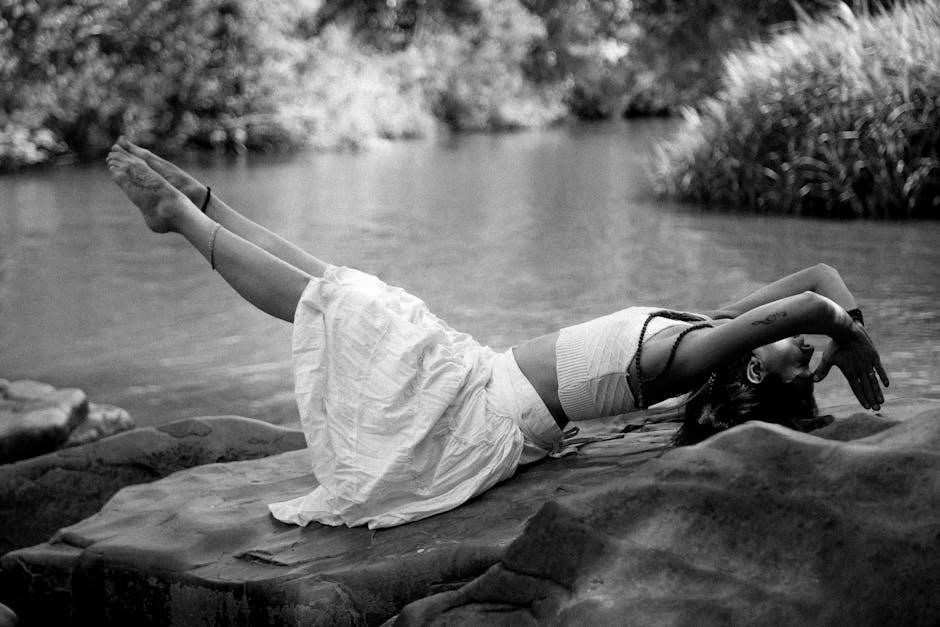
Popular sequences include Morning Flow for energizing starts, Full-Body Flow for strength, Moon Sequence for gentle rhythms, and Detoxifying Flow for twists and cleansing movements.
Morning Vinyasa Flow Yoga Sequence
A Morning Vinyasa Flow Yoga Sequence is designed to energize and awaken the body. It typically begins with gentle stretches and sun salutations to warm up the muscles. The sequence often includes poses like Mountain Pose, Downward Dog, and Warrior II to build strength and flexibility. Synchronized breathing with movement helps create a meditative flow, preparing the body for the day ahead. This practice is ideal for setting intentions and boosting energy levels. Many sequences are structured as 20-30 minute flows, incorporating balancing poses like Tree Pose and twists to enhance circulation. The goal is to create a harmonious connection between body and mind, fostering vitality and clarity from the start of the day. Regular practice can lead to improved physical and mental well-being.
Full-Body Vinyasa Flow Yoga Sequence
A Full-Body Vinyasa Flow Yoga Sequence is a comprehensive practice designed to engage all major muscle groups. It typically begins with a warm-up, incorporating sun salutations to raise the heart rate and prepare the body. The sequence progresses through standing poses like Warrior I and II, which strengthen the legs and hips, followed by balancing poses such as Tree Pose to improve stability. Backbends like Cobra Pose and forward folds like Standing Forward Bend are included to enhance flexibility. Core-strengthening poses and inversions may also be added for a challenging yet balanced practice. This sequence aims to promote overall physical fitness, leaving practitioners feeling strong, stretched, and invigorated. Regular practice supports improved posture, increased energy, and enhanced mental clarity.
Moon Sequence (Chandra Krama) in Vinyasa Flow
The Moon Sequence, or Chandra Krama, is a gentle and meditative Vinyasa Flow practice designed to promote relaxation and flexibility. Developed by Matthew Sweeney in Vinyasa Krama, this sequence focuses on slow, flowing movements synchronized with the breath. It typically includes poses such as Seated Forward Bend, Half Moon Pose, and twisting postures to release tension and enhance spinal flexibility. The sequence is structured to create a calming and rejuvenating experience, making it ideal for those seeking to unwind and restore balance. Practicing Chandra Krama helps cultivate inner peace, improves circulation, and strengthens the body’s natural energy flow. It is often recommended for beginners or those looking for a slower-paced, therapeutic practice.
Detoxifying Vinyasa Flow Sequence
A Detoxifying Vinyasa Flow Sequence is designed to cleanse and rejuvenate the body. It incorporates poses that stimulate digestion, improve circulation, and release toxins. Twists and forward bends, such as Seated Forward Bend and Marichyasana, help detoxify the liver and kidneys. Sun salutations and dynamic flows increase blood flow, promoting the elimination of waste. Breathwork, particularly Ujjayi, enhances internal cleansing. The sequence may include balancing poses to refresh the nervous system and inversions like Downward Dog to boost lymphatic drainage. Ending with restorative poses encourages deep relaxation, allowing the body to release stress and renew energy. This practice is perfect for restoring balance and revitalizing the body’s natural detox processes, leaving you feeling refreshed and invigorated.

Health and Wellness Benefits of Vinyasa Flow
Vinyasa Flow enhances strength, flexibility, and cardiovascular health while reducing stress through synchronized breath and movement, promoting a meditative state that naturally rejuvenates both body and mind.
Building Strength and Flexibility
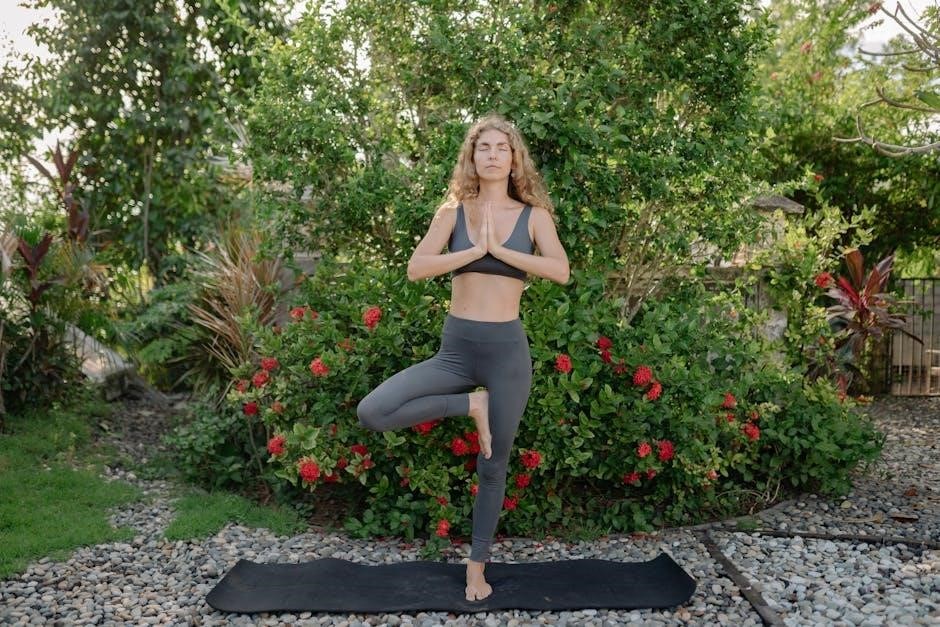
Vinyasa Flow Yoga is renowned for its ability to build strength and enhance flexibility. By engaging in dynamic sequences like Sun Salutations, lunges, and balancing poses, practitioners strengthen major muscle groups while improving range of motion. The flow’s repetitive movements, such as transitions between Plank, Chaturanga, and Upward-Facing Dog, target core muscles, arms, and legs, fostering endurance and power. Simultaneously, the practice encourages deep stretching, particularly in the hamstrings, hips, and spine, leading to improved flexibility. Regular practice not only tones the body but also creates a balanced physique, making it an effective way to enhance overall physical fitness and mobility.
Improving Balance and Coordination
Vinyasa Flow Yoga excels at enhancing balance and coordination by combining flowing movements with mindful breathing. The practice encourages holding poses for extended periods and transitioning smoothly between them, which challenges the body’s stability and focus. Sequences like Sun Salutations and balancing postures such as Warrior II, Tree Pose, and Eagle Pose require precision and control, strengthening the connection between mind and body. Regular practice improves proprioception, allowing practitioners to move with greater grace and awareness. By refining alignment and timing, Vinyasa Flow Yoga helps build coordination while fostering a sense of grounding and equilibrium, making it an excellent choice for improving overall physical and mental balance.
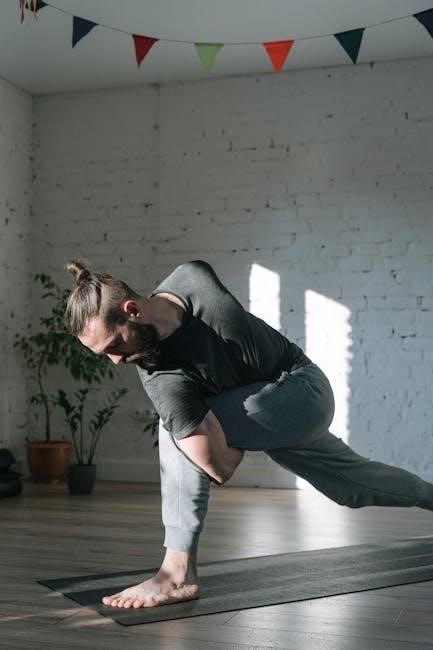
Enhancing Cardiovascular Health
Vinyasa Flow Yoga significantly contributes to cardiovascular well-being by incorporating dynamic movements and sustained postures. The flowing sequences, such as Sun Salutations and continuous transitions, elevate heart rate, improving circulation and stamina. Regular practice strengthens the heart muscle, enhancing its efficiency in pumping blood. Additionally, the rhythmic breathing synchronized with movement helps lower resting heart rate and blood pressure, promoting overall cardiovascular health. Over time, this practice can increase oxygen delivery to cells and boost the body’s energy levels, making it an effective way to support a healthy heart and maintain physical vitality through consistent practice.
Reducing Stress and Anxiety
Vinyasa Flow Yoga is a powerful tool for reducing stress and anxiety by combining dynamic movement with mindful breathing. The continuous flow of poses synchronizes with the breath, creating a meditative state that calms the mind. This practice helps lower cortisol levels, the body’s primary stress hormone, and promotes relaxation. The physical activity releases endorphins, which boost mood and reduce anxiety. Additionally, the focus on breath and movement distracts from daily worries, fostering mental clarity. Regular practice enhances emotional resilience, helping individuals manage stress more effectively. Over time, Vinyasa Flow Yoga cultivates a sense of inner peace, making it an excellent practice for maintaining mental well-being and reducing stress and anxiety in a fast-paced world.
Advanced Vinyasa Flow Yoga Techniques
Master advanced poses like inversions and backbends, refine transitions, and explore complex flows. These techniques challenge the body and mind, deepening strength, flexibility, and focus in practice.
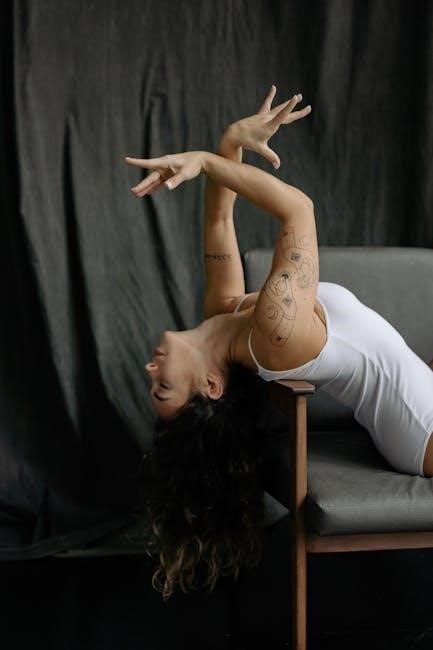
Incorporating Inversions and Backbends
Incorporating inversions and backbends into your Vinyasa Flow Yoga sequence can enhance strength, flexibility, and balance. Inversions, such as Adho Mukha Vrksasana (Handstand) or Pincha Mayurasana (Feathered Peacock Pose), challenge the body and improve focus. Backbends like Urdhva Dhanurasana (Wheel Pose) or Viparita Dandasana (Inverted Staff Pose) open the chest and shoulders, promoting a deeper breath and emotional release. These advanced poses require proper alignment and preparation to ensure safety and effectiveness. Start with modified versions if needed, using props or walls for support. Gradually build strength and confidence to master these transformative poses, which add depth and variety to your practice.
Advanced Transitions and Flows
Advanced transitions in Vinyasa Flow Yoga involve seamless and dynamic movements that connect poses with precision and grace. These flows, such as intricate sun salutations or mandala vinyasa, challenge coordination and breath awareness. Practitioners can explore reversing sequences or incorporating circular flows to deepen their practice. Smooth transitions enhance fluidity, making the practice more meditative. Advanced flows often include poses like crow or wheel, requiring strength and control. Mastery of these transitions not only improves physical agility but also mental focus. Always listen to your body and modify as needed to ensure a safe and enjoyable experience. Advanced transitions add variety and depth to your Vinyasa Flow practice, keeping it engaging and transformative.
Modifying Poses for Different Levels
Modifying poses in Vinyasa Flow Yoga ensures accessibility for all practitioners, regardless of skill level. Beginners can use blocks or modify postures like downward dog by bending the knees. Intermediate students might deepen stretches or hold balances longer, while advanced practitioners can incorporate inversions or complex transitions. Offering variations allows each student to honor their body’s capabilities while progressing safely. Modifications also prevent injury and promote a sustainable practice. Encouraging the use of props or alternative poses maintains a inclusive environment, ensuring everyone benefits from the sequence. This approach fosters growth and confidence, making Vinyasa Flow Yoga adaptable to diverse needs and goals.
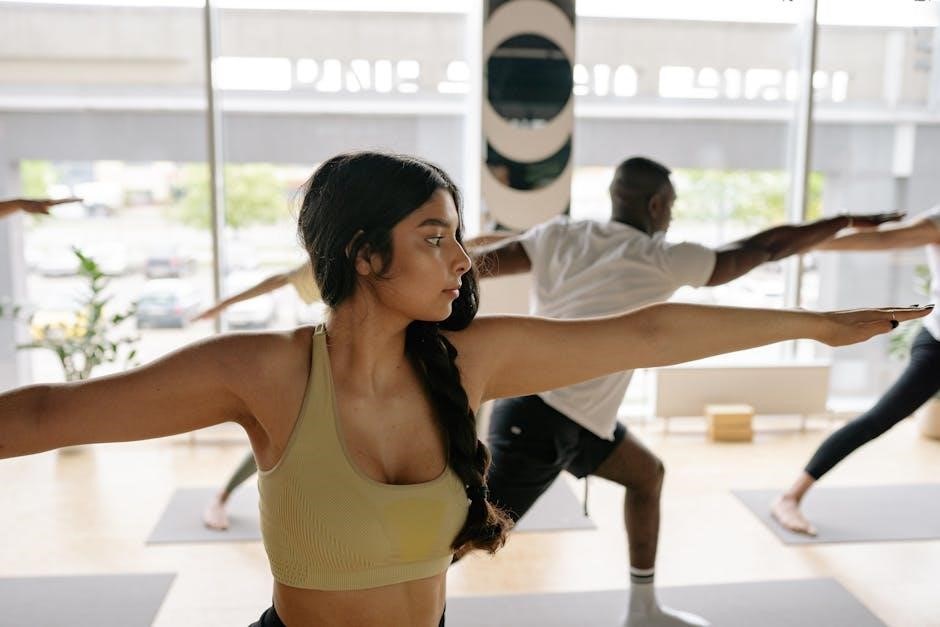
Creating Your Own Vinyasa Flow Yoga Sequence
Design your Vinyasa Flow sequence by setting an intention, incorporating warm-ups, building to a peak pose, and including variations for different levels to ensure a balanced practice.
Structuring a Balanced Practice
A balanced Vinyasa Flow practice begins with setting an intention, followed by a warm-up to prepare the body. Include foundational postures like Sun Salutations to build heat and flexibility. Transition into a dynamic sequence, linking breath with movement, and incorporate strength-building poses. Introduce peak postures to challenge the body, ensuring proper alignment and modifications for all levels. Conclude with cooling stretches and relaxation techniques, such as Savasana, to calm the mind and body. Aim for a 20-60 minute flow, depending on your goals, and always prioritize synchronization of breath and movement for a holistic experience. This structure ensures a well-rounded practice that honors both physical and mental well-being.
Sequencing for Specific Goals (Strength, Flexibility, etc.)
When structuring a Vinyasa Flow sequence for specific goals, focus on poses that target the desired outcome. For strength, incorporate dynamic flows like Sun Salutations, Warrior poses, and lunges to build heat and endurance. For flexibility, emphasize deep stretches in poses such as Downward Dog, Pigeon, and seated forward bends. Balance strength and flexibility by alternating between challenging postures and restorative stretches. Include peak poses to highlight the sequence’s intent, ensuring proper alignment and breath synchronization. Modify poses to suit all levels, allowing students to explore their potential safely. This intentional sequencing creates a focused practice tailored to achieve specific physical and mental benefits, fostering progress and mindfulness. Always conclude with cooling poses to integrate the effects of the practice.
Incorporating Peak Poses in Your Sequence
Incorporating peak poses into your Vinyasa Flow sequence adds depth and challenges, helping students build strength and confidence. A peak pose, like Crow Pose or Warrior III, is typically introduced toward the end of the practice when the body is warm and prepared. Begin by building a foundation with Sun Salutations and preparatory poses to ensure proper alignment and readiness. Use breath-synchronized movements to transition smoothly into the peak pose, providing modifications for different levels. Encourage students to hold the pose for a few breaths to fully experience its benefits. Afterward, guide them through a cooling sequence to release tension and integrate the effects. This structured approach ensures a safe and transformative practice, allowing students to explore their potential mindfully.
Vinyasa Flow Yoga is a transformative practice combining breath, movement, and mindfulness; Regular practice enhances strength, flexibility, and mental clarity, fostering holistic well-being. Embrace its flow for lifelong growth.
Final Thoughts on Vinyasa Flow Yoga
Vinyasa Flow Yoga is a powerful practice that unites breath, movement, and mindfulness, offering a holistic approach to physical and mental well-being. By synchronizing breath with dynamic flows, practitioners experience enhanced strength, flexibility, and balance. This versatile practice is accessible to all levels, from beginners to advanced yogis, making it a popular choice for those seeking transformation. Whether aiming to build strength, improve flexibility, or reduce stress, Vinyasa Flow provides a meaningful journey toward self-discovery and growth. Embrace its fluid sequences and let the flow guide you toward a more balanced, energetic, and mindful life. Regular practice fosters resilience, both on and off the mat.
Encouragement to Practice and Explore
Embrace Vinyasa Flow Yoga as a journey of self-discovery and growth. Begin with short sequences, gradually exploring more complex flows as confidence builds. Listen to your body, honoring its limits while challenging yourself. Each practice is an opportunity to deepen your connection with breath and movement. Experiment with different sequences, such as morning flows for energy or detoxifying flows for renewal. Share your experiences, inspire others, and allow the practice to evolve with you. Remember, yoga is a personal journey—enjoy the process, celebrate progress, and embrace the transformative power of Vinyasa Flow Yoga in your life.
